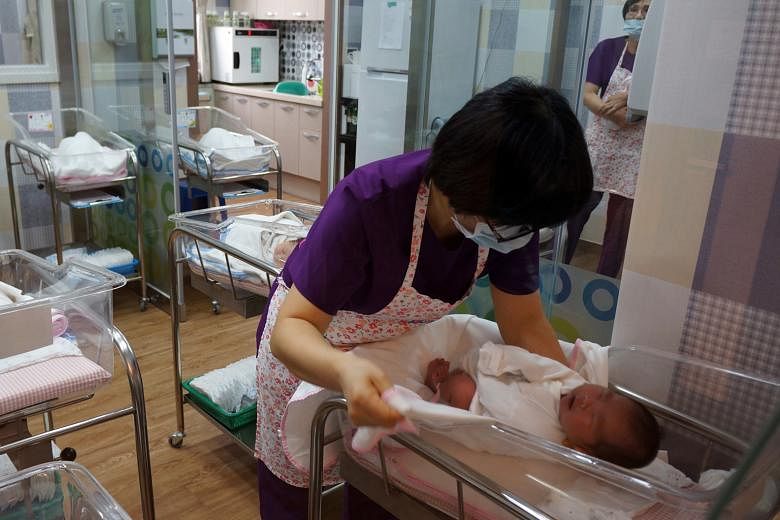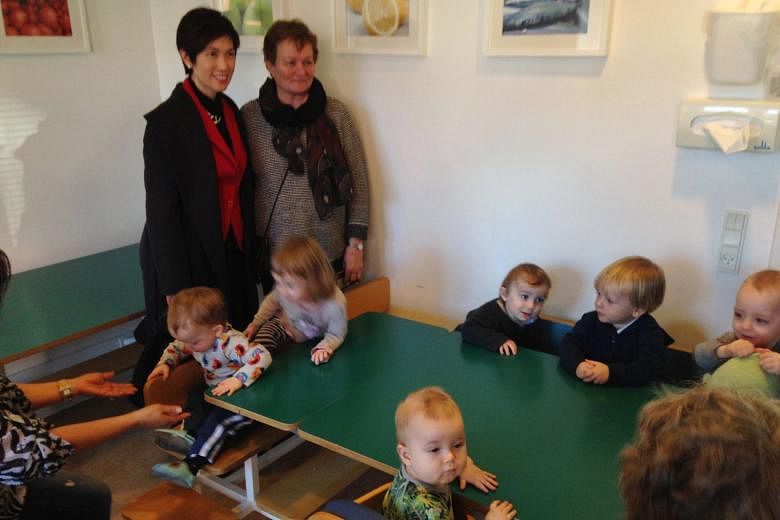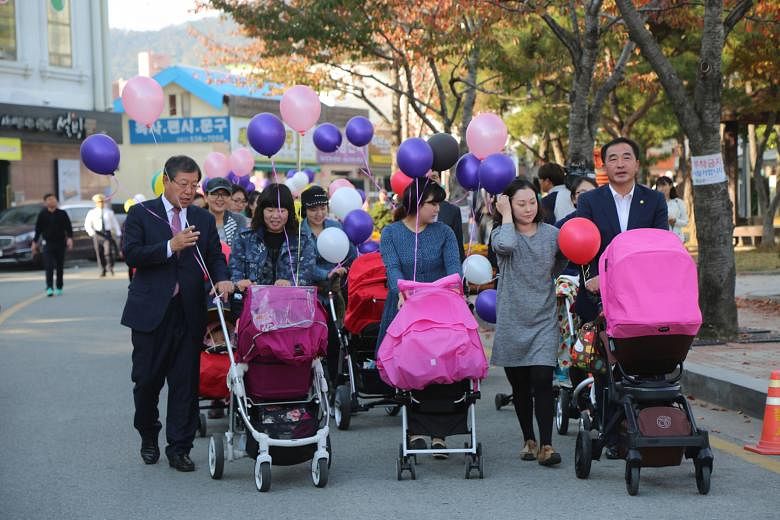South Korea has a pressing problem that Singapore is only too familiar with: Not enough babies are being born to sustain the population.
Already, South Korea's working-age population will begin to fall after this year .
If the stork does not increase its deliveries, the total population there will start to shrink after 2030.
After that, the demand for labour will exceed the number of workers available, exacerbated by a rapidly ageing population.
South Korea's economy is projected to slow as a result.
At the same time, there will not be enough locals to staff the military, and there will be more university places than high school graduates.
The Korean government sat up and took notice when its total fertility rate - the average number of children a woman will have over her lifetime - hit a record low of 1.08 in 2005.
This is well below the replacement rate of 2.1 births per woman.
It began its first five-year national plan to boost the birth rate, which covered different angles, from subsidising infertility treatments to raising childcare leave benefits.
Now in its third edition and trillions of Korean won later, South Korea's total fertility rate inched back upwards to 1.21 in 2014 - very close to Singapore's 1.25 that same year.
Given the Korean experience of having thrown lots of government money at the problem, with limited success, it is small wonder that Singapore's policymakers are closely watching their fellow Asian tiger.
LESSONS FROM SCANDINAVIA
Enter Denmark.
The Scandinavian welfare state's population of 5.6 million is close to Singapore's 5.4 million, but the resemblance stops there.
While about 3 per cent of children in Singapore are born outside marriage, in Denmark, more than half are.
Its total fertility rate in 2014 was 1.7 - below replacement, but high enough to indicate that some lessons might be gleaned from its success.
Last month, officials from Singapore's National Population and Talent Division went on a study trip to South Korea and Denmark to look at what marriage and parenthood policies worked and what did not.
Insight was part of the media delegation on the trip.
Led by Senior Minister of State Josephine Teo, whose duties include overseeing population matters, the policymakers looked at a wide range of topics, from labour agreements and home-based infant care arrangements in Denmark's capital, Copenhagen, to family-friendly companies and even dating agencies in Seoul.
Singapore's interest comes amid the Government's push to expand paternity leave and explore new arrangements to care for infants, to raise Singapore's total fertility rate from its dismal 1.25.
How might this targeting of married couples interested in having children - and encouraging parents to have more - work?
Government policies may be one part of the equation, but while these are necessary, they are not in themselves sufficient for change.
Insight extracts five possible ingredients for success from the field trip and what it will take for Singapore to have them.
1. PATERNITY LEAVE

Ensuring that dads don't lose out in pay seems crucial. But who foots the bill?
Fathers in South Korea get five days of paternity leave, a scheme introduced in 2011 to boost the flagging birth rate.
Danish dads get two weeks off, with the option to share up to 32 weeks of parental leave with their partners.
Yet the take-up rate differs drastically.
While 60 per cent of Danish fathers take up paternity leave, less than 2 per cent in South Korea do so.
In Singapore, bosses must offer new dads one week of paternity leave, funded by the Government. While dads are eligible for a second week of government-paid paternity leave, it is up to the employer to voluntarily agree to this.
With Singapore's upcoming move to make the second week of paternity leave compulsory, lessons from Denmark and South Korea will be instructive.
The move is likely to be announced this month during the parliamentary debate on ministries' budgets.
The drive for more paternity leave comes three years after the scheme was first rolled out in 2013, and aims to encourage married couples to share the responsibility of parenting.
But in the lead-up, the Government has faced some resistance from businesses, many of which are already grappling with a manpower crunch.
Dads being gone for up to two weeks at a stretch will place even more of a strain on their operations, bosses argue.
One factor for success may be the Government's willingness to foot the bill.
In South Korea, fathers who are on paternity leave have to forgo their salary.
Instead, they are given an allowance of40per cent of their monthly salary from the government, capped at 1.5 million won($1,760).
"This 1.5 million won seems insignificant. That is why income replacement policies seem to be necessary from our viewpoint," says associate research fellow at the Korea Institute for Health and Social Affairs think-tank Park Jong Seo.
In Denmark, where collective agreements for working conditions are negotiated by employer federations and labour unions, companies pick up the tab for parental leave.
But in Singapore, both weeks of paternity leave - the compulsory element, and the week requiring the employer's agreement - are funded by the Government, with each week capped at $2,500.
The lesson for Singapore appears to be that fully funding paternity leave makes it more likely that dads will find taking it up worthwhile.
But for Singapore, paternity leave is likely to be more popular if the Government foots the bill, as companies already struggle with high labour costs.
2. SUPPORTIVE BOSSES

In Korea, employers are stuck in the old mindset; in Denmark, it's about good business sense
Government baby-boosting policies and funds can only go so far if employers are reluctant to get on board.
"You can have the same policy, but whether it has the same impact depends very much on the level of community support. So employers play a very big part in this," said Senior Minister of State Josephine Teo in an interview with the media, on the push to get dads more involved.
Korea's officials and researchers think so too, pointing to how men are reluctant to take paternity and parental leave because of being perceived as lazy or unmotivated by their bosses.
The numbers are telling.
A study by the Organisation for Economic Cooperation and Development group of economies shows Korean men spend 4.6 hours per week on housework and childcare, compared to the 22 hours that Danish men put in at home.
Korean Employment and Labour Minister Lee Ki Kweon said: "Korean workers are conscious about how their colleagues and bosses perceive their leave taking.
"There is a need to help business owners change their mindsets."
Another complication is that employees of small firms find it harder to take parental leave.
For every 11.2 employees in big corporations who take childcare leave, only 4.6 employees in small and medium-sized enterprises do so, according to statistics from Korea's Ministry of Health and Welfare.
To tackle this, Korea plans to expand support services for hiring substitute workers to fill in while the new fathers or mothers are away.
As for Denmark, employer support there appears to be stronger and parents greatly value the availability of flexible work arrangements, noted Mrs Teo in the same media interview.
But ultimately, employers have to decide that it makes good business sense to offer their employees such pro-family leave policies, because it attracts talented workers, she said.
"Ultimately the businesses are doing it because it meets their business interests. They're not doing it for charity. They didn't sit there and tell us, 'It's because we want to be good corporate citizens'. No, they told us very clearly that it makes good business sense."
3. WORK-LIFE BALANCE
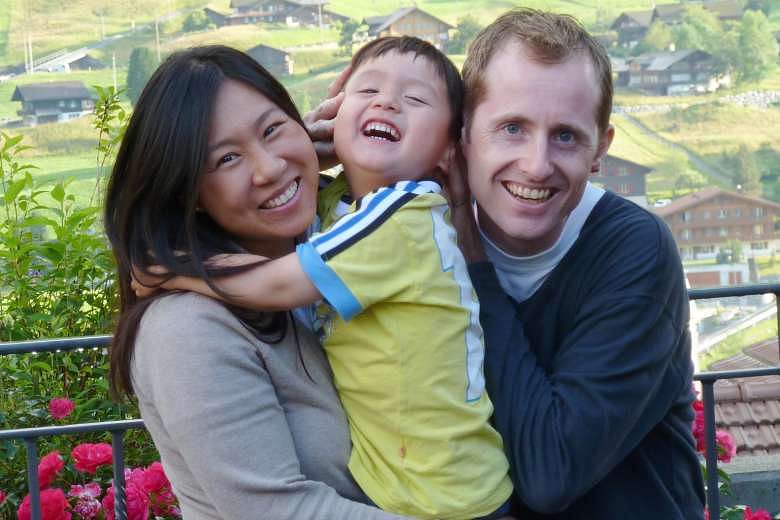
Less work = more kids. But can cultures that 'stigmatise' doing less adapt to the change effectively? After 4pm, one would be hard-pressed to find working parents of young children still in the office in Denmark.
Chalk it up to the strong culture of work-life balance there.
Danish commodities trader Florian Friis, 42, father of a seven-year-old boy, said: "It's considered a little impolite or silly if you book a meeting with parents after 4pm. Most likely, they will not show up or they will leave after 10 minutes to pick up their children."
Mr Friis and his Singaporean wife Elaine, 41, a contracts and procurement associate, are expecting their second child next month.
Like her Danish colleagues, she leaves earlier to pick up her son and makes up for it later at night, and works at home once a week.
Said Mr Friis: "There's a general acceptance that that's just what you do when you have a kid. It's totally normal."
When it comes to work-life balance, Denmark and Korea lie at different ends of the spectrum.
Part of this is the number of hours worked. Koreans worked for 2,124 hours on average in 2014, the second-longest in the OECD's 34 economies.
In contrast, Danes worked an average of 1,436 hours that year, the fourth-lowest among the OECD.
The other part is cultural norms.
"If someone goes home earlier than their superiors, it's frowned upon," said Ms Kim Yuna, senior manager at Korea Technology Finance Corporation (Kotec), a family-friendly firm the Singaporean delegation visited.
That is why Korea's working mums may choose to not make use of flexible work arrangements. The organisational culture is such that workers might also resent their colleagues on parental leave for increasing their own workload, added Ms Kim.
But in Korea, achieving work-life balance is still seen as the key to growth in fertility for women. The Korean health and welfare ministry found that women with good work-life balance have more kids.
While working women in general have 0.7 children each on average, female government officials have 1.4. The civil service is seen as having a better work-life balance than the private sector.
Singapore's average working hours of 46 hours a week in 2014 is more like Korea's 47-hour work week, rather than Denmark's 37.
As such, any change in culture will take time - as was the case at Kotec, which introduced work-life policies, such as flexible working hours and starting times, as well as remote offices outside its regional headquarters in 2012.
"When we started to implement this, it was difficult to change people's preconceptions of what it was like before, " says Kotec human resources manager Jo Gyu Dae. But the take-up rate improved over time, as did workers' productivity, he added.
Singapore may have to weigh the trade-offs between costs, and happier employees and a higher birthrate.
4. INFANT CARE: MORE OPTIONS
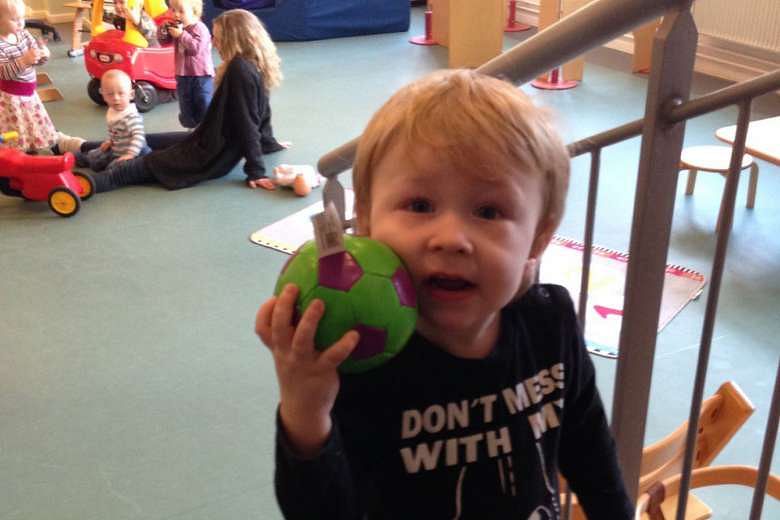
Danes enjoy subsidised private daycare - but the downside is high taxes
While working parents in Singapore can often look to their own parents for childcare help, or hire a maid, or put their young ones in a private care centre, Danish mums and dads have an additional option.
This is state-subsidised care by home-based private child-minders in their own neighbourhood.
In Denmark, working parents can choose to send their infants to the homes of private child-minders. The infants are looked after, together with other children in the neighbourhood, in these home- based settings during the day.
Under the Danish system of private daycare, municipalities can employ a parent to take care of her own child as well as the child of another family. The subsidies are similar across all daycare types.
Professionally trained in early childhood education and paid by the state, these registered child-minders in private daycare are visited regularly by supervisors.
Parents who want more academic training to help their children start to learn numbers and grammar, in preparation for their school years, can opt for nurseries.
Such private daycare is part of Denmark's extensive network of infant care, which helps give mothers the peace of mind to return to work after giving birth, if they want to.
State subsidies mean parents fork out less cash for infant care.
And with only a small number of children cared for in such settings conveniently located in the neighbourhood, they receive a lot of personal attention.
Other forms of daycare for young infants range from differently sized public daycare centres to nurseries to private child-minding.
Danish children have the right to a childcare spot from the age of six months, which must be provided for by their municipality.
"It lowers the anxiety of having children," says sociologist Karen Margrethe Dahl from the Danish National Centre for Social Research.
About 75 per cent of the cost of childcare is subsidised, with parents paying the remaining 25 per cent. The cost is borne by the municipality, which also sets the range of prices paid by parents.
Singapore's policymakers are interested in exploring whether the Danish system of home-based private child-minders will work here.
"Many people in Singapore were brought up by nannies, so it's not as if home-based childcare did not exist. It existed," says Mrs Teo.
But over time, parents began to prefer a more supervised setting, where the caregiver is known to have gone through professional training in childcare.
Now, it will depend on how comfortable parents are with taking their children to another person's home these days, she adds.
"We'll have to study it a little bit more - what are the features that parents find helpful and want, and how we can organise it," she says.
GOVT FUNDING, AT A COST
The model is one thing. How to pay for it is another.
The Danish government's universal provision of such childcare services is made possible by high taxes.
In Denmark, the personal income tax rate stands between 46 and 51 per cent of gross income, and in terms of consumption taxes, Danes pay a value-added tax of 25 per cent on all purchases.
Government funding may also not necessarily ease the financial burden of raising children.
For instance, South Korea expanded free childcare for children from newborn to five years to all families, regardless of household income, in 2013.
It was part of a national drive to reduce the childcare burden for married couples, and the budget increased from 1.8 trillion won to 6.7 trillion won (S$8 billion).
This reduced the proportion of household income spent on childcare from 6 per cent to about 3.4 per cent, according to statistics from the Korean Ministry of Health and Welfare.
But ironically, parents spent these savings on more private education for their children instead, said policymakers there.
5. SOCIETAL ATTITUDES

MARK OF DENMARK
In Korea, fathers are seen as providers; in Denmark, fathers are known to be nurturers too
Another key difference between Denmark and Korea is how involved fathers are in raising their children.
This affects the take-up rate for paternity leave.
Says Kihasa associate research fellow Kim Jun Eung: "Traditionally, Koreans think it is the woman's responsibility to take care of the kids.
"In the past, dad will work outside while mum takes care of the housework, and that view has remained."
This is why the culture of fathers taking leave is still uncommon, adds her colleague, Dr Park .
However in Denmark, it is common to see fathers ferrying their children to daycare centres or pushing prams on the streets.
Says Danish-based Singaporean, Ms Ng-Friis : "You see a lot of fathers pushing prams on the streets. This is one big characteristic of Denmark. Fathers are very involved here and that makes the family work."
Things changed a lot in one generation, says her husband Mr Friis, recounting how his father spent much less time with him and his siblings.
"Back in the 1970s and 1980s, it was quite common that a man would go to work and prioritise his job, even if he would have got away with coming home a bit earlier," he says.
When it comes to Singapore today, Mrs Teo is optimistic, noting that young fathers whom she has met are enthusiastic about wanting to be involved in parenting.
This is unlike previous generations where men were more comfortable solely in the traditional role of provider for the family.
"A lot of fathers talk about the joy that they get out of bonding with their children at different ages, and starting from a very young age, soon after birth," she says.
"I think the time has come for Singapore, for fathers, because they're willing to play a bigger part and we should enable it."
